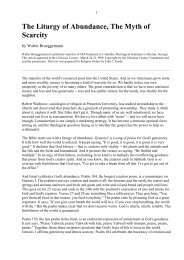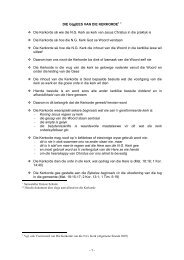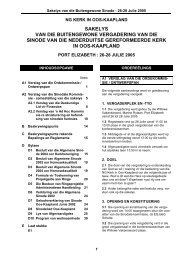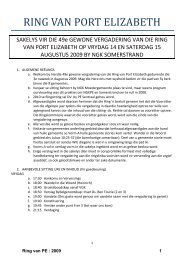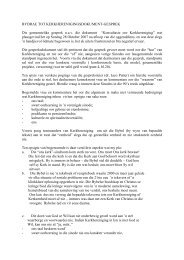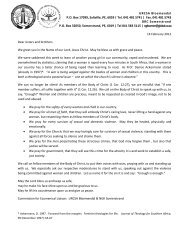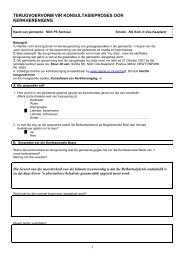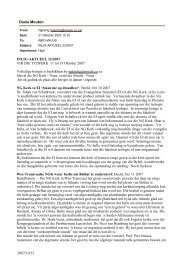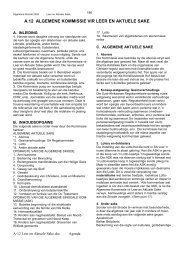Create successful ePaper yourself
Turn your PDF publications into a flip-book with our unique Google optimized e-Paper software.
It is important to <strong>in</strong>sist that the word [ecumenical], which comes from the Greek word for the whole<br />
<strong>in</strong>habited earth [oikoumene], is properly used to describe everyth<strong>in</strong>g that relates to the whole task of the<br />
whole church to br<strong>in</strong>g the gospel to the whole world.<br />
This sought to expand previous def<strong>in</strong>itions by <strong>in</strong>tegrat<strong>in</strong>g the concern for church unity and the concern for<br />
cooperative mission and evangelism.<br />
2.4 More recent descriptions of the goal of the ecumenical movement have sought to take seriously the<br />
conviction that the object of God's reconcil<strong>in</strong>g purpose is not only the church but the whole of humanity -<br />
<strong>in</strong>deed, the whole of creation. Thus, the WCC's Vancouver Assembly (1983) spoke of a "eucharistic vision"<br />
which<br />
unites our two profoundest ecumenical concerns: the unity and renewal of the church and the heal<strong>in</strong>g and<br />
dest<strong>in</strong>y of the human community. Church unity is vital to the health of the church and to the future of the<br />
human family... Christ - the life of the world - unites heaven and earth, God and world, spiritual and secular.<br />
His body and blood, given to us <strong>in</strong> the elements of bread and w<strong>in</strong>e, <strong>in</strong>tegrate liturgy and diaconate,<br />
proclamation and acts of heal<strong>in</strong>g... Our eucharistic vision thus encompasses the whole reality of Christian<br />
worship, life and witness.<br />
The Canberra Assembly (1991) added: "We need desperately a mobiliz<strong>in</strong>g portrait of reconciled life that will<br />
hold together an absolute commitment to the unity and renewal of the church and an absolute commitment<br />
to the reconciliation of God's world... We need to affirm the vision of an <strong>in</strong>habited world (oikoumene) based<br />
on values which promote life for all." However, these two Assembly statements do not go much beyond the<br />
affirmation that the various dimensions need to be held together.<br />
2.5 With<strong>in</strong> the ecumenical movement the WCC has sought to <strong>in</strong>tegrate the vision of John 17:21 ("that they<br />
may all be one... so that the world may believe") with the vision of Ephesians 1:10 (God's "plan for the<br />
fullness of time, to gather up all th<strong>in</strong>gs <strong>in</strong> [Christ], th<strong>in</strong>gs <strong>in</strong> heaven and th<strong>in</strong>gs on earth"). But the effort to<br />
<strong>in</strong>tegrate these two biblical visions has been challenged by a cont<strong>in</strong>u<strong>in</strong>g tension and sometimes<br />
antagonism between those who advocate the primacy of the social dimension of ecumenism and those who<br />
advocate the primacy of spiritual or ecclesial ecumenism.<br />
2.6 More recently, a grow<strong>in</strong>g number of voices from the churches, especially <strong>in</strong> Asia but also <strong>in</strong> Lat<strong>in</strong><br />
America, have spoken of the need for a "wider ecumenism" or "macro-ecumenism" - an understand<strong>in</strong>g<br />
which would open the ecumenical movement to other religious and cultural traditions beyond the Christian<br />
community.<br />
2.7 These ambiguities surround<strong>in</strong>g the understand<strong>in</strong>g of "ecumenical" create the real danger of <strong>in</strong>troduc<strong>in</strong>g<br />
competitive divisions <strong>in</strong>to the ecumenical movement. What is the mean<strong>in</strong>g and purpose of this movement?<br />
Who are its subjects? What are its goals and methods or forms of action? What is the source of the<br />
dynamic which warrants speak<strong>in</strong>g of the "ecumenical movement" beyond its <strong>in</strong>stitutional manifestations <strong>in</strong><br />
the WCC and elsewhere?<br />
Some basic dist<strong>in</strong>ctions and marks of identification<br />
2.8 In the present situation of uncerta<strong>in</strong>ty and transition, the ambiguities surround<strong>in</strong>g the mean<strong>in</strong>g of the term<br />
"ecumenical" will not be resolved by a descriptive - even less a normative - def<strong>in</strong>ition which identifies a<br />
particular model, strategy or organizational affiliation as criteria for what is "ecumenical". Any common<br />
understand<strong>in</strong>g will have to embrace multiple perspectives and a diversity of subjects. Nevertheless, a<br />
number of basic dist<strong>in</strong>ctions may help to clarify the use of the term here:<br />
2.8.1 The dynamic of the ecumenical movement is rooted <strong>in</strong> the tension between the churches as<br />
they are and the true ko<strong>in</strong>onia with the triune God and among one another which is their call<strong>in</strong>g and God's<br />
gift.<br />
2.8.2 The ecumenical vision encompasses the renewal of church and world <strong>in</strong> the light of the gospel<br />
of God's k<strong>in</strong>gdom. In the face of all threats to life it affirms the Christian hope of life for all<br />
2.8.3 The ecumenical movement, while it shares <strong>in</strong> other efforts at <strong>in</strong>ternational, <strong>in</strong>ter-cultural, and<br />
<strong>in</strong>terreligious cooperation and dialogue, is rooted <strong>in</strong> the life of the Christian churches. Yet it is not limited to<br />
the concern for <strong>in</strong>ter-church relationships and is wider than the various organizations <strong>in</strong> which it has found<br />
expression.<br />
2.8.4 The ecumenical movement seeks to foster cooperation and shar<strong>in</strong>g, common witness and<br />
common action by the churches and their members. More specifically, however, it is a renewal movement<br />
<strong>in</strong> and through the churches which has found expression <strong>in</strong> diverse <strong>in</strong>itiatives and networks among lay<br />
people, especially women and youth. It is committed to the search for visible unity, not as an end <strong>in</strong> itself<br />
but <strong>in</strong> order to give credible witness "so that the world may believe" and to serve the heal<strong>in</strong>g of the human<br />
community and the wholeness of God's entire creation.<br />
2.8.5 While the ecumenical movement has a worldwide scope - <strong>in</strong> l<strong>in</strong>e with the orig<strong>in</strong>al use of the<br />
word oikoumene for "the whole <strong>in</strong>habited earth - it po<strong>in</strong>ts more specifically to the catholicity of the church,<br />
that is, globally. In each place and <strong>in</strong> all places, the ecumenical movement is concerned with the true be<strong>in</strong>g<br />
and life of the church as an <strong>in</strong>clusive community.<br />
2.9 The emergence over the last decades of transnational and <strong>in</strong>creas<strong>in</strong>gly worldwide structures of<br />
communication, f<strong>in</strong>ance and economy has created a particular k<strong>in</strong>d of global unity. It is evident that the cost<br />
of this has been grow<strong>in</strong>g fragmentation of societies and exclusion for more and more of the human family.<br />
ÏÓÏ



